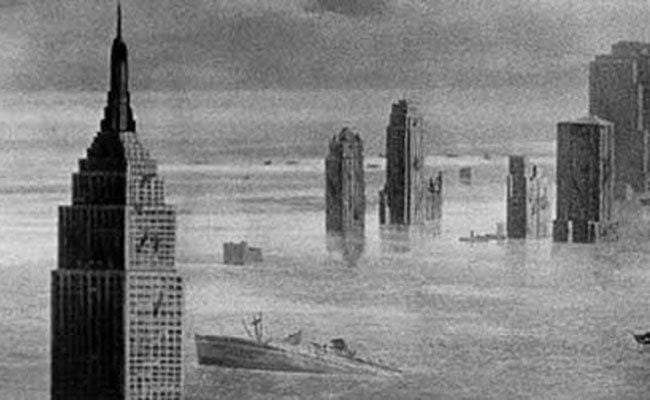While most of the titles in Kino Lorber’s Studio Classics line of Blu-rays are reasonably well-known titles that have been on DVD before, the company here performs a service in exhuming a pre-Code spectacle lost for decades. It’s of special interest to fans of old-school physical effects and early science fiction talkies.
Deluge is an early example of what we now call the disaster film, though at the time it was advertised as a spectacle whose closest model was the same year’s King Kong. Based on a popular English novel by S. Fowler Wright, it posits an apocalypse convulsing the world with earthquakes and tsunamis, leaving survivors to rebuild.
This indie production, picked up for distribution by RKO, blows what budget it had on the big catastrophe sequence, which involves a lot of model work of collapsing New York skyscrapers combined with matte shots of crowds and ruined vistas. It’s very obvious to the spoiled modern eye, and this may prevent some of today’s viewers from appreciating the effects. Film aficionados, however, may look at it differently.
Although not as striking as those in King Kong and some contemporary productions, Deluge displays the exuberance of destruction that seems to feed our atavistic fears and desires to this day. We’re struck by the audacity of conception as much as, or more than, the execution, especially when we see the Statue of Liberty overwhelmed by tidal waves. These ideas were restaged digitally in the 2004 The Day After Tomorrow, as someone has helpfully demonstrated on YouTube (see clip below).
Most of the post-disaster section is shot at Bronson Canyon, now familiar from a thousand other movies and TV shows. It involves a bland hero (Sidney Blackmer) who rescues a blonde bombshell (Peggy Shannon) from a gang of rapist-murderers and takes her as his common-law wife until he discovers his own wife (Lois Wilson) is still alive. The soap operatics of this long anti-climax can be fairly described as turgid, livened only by the pre-Code sexual elements.
The disaster footage was recycled in later productions, such as serials by Republic Pictures. The rest of the feature was lost in the historical shuffle until an Italian-dubbed print was discovered in the ’80s, but this print with the English soundtrack was only discovered in 2016 and restored by France’s Lobster Films in a print that looks and sounds swell. This history, along with much info about the cast and crew and an endorsement of the Fowler’s novel and its differences from the screenplay, is provided in a typically informative commentary from genre maven Richard Harland Smith.
A very pleasant bonus is a second movie starring Shannon. Back Page (1934), also restored by Lobster, is an obviously cheap “Poverty Row” indie, yet it’s smarter and more consistently entertaining than the main feature. As the title implies, it’s a newspaper comedy floating in the backwash of the hit called The Front Page, now as a woman-centered variant.
“I’m a good newspaperman, and I know it!” exclaims Jerry Hampton (Shannon), who’s not interested in marriage without having a job. When politics blackballs her from a city paper, she runs a small-town rag that exposes local corruption in a wildly coincidental manner. Shannon, who would die at 34 from alcoholism, gives a magnetic, spunky and sexy performance as a heroine with brains.
She’s supported gamely by Claude Gillingwater, Russell Hopton, Edwin Maxwell, Sterling Holloway, and Ottola Nesmith in a film credited to a director named Anton Lorenze. Surely it’s not the Hungarian furniture designer Anton Lorenz, and since this is his only credit, someone at IMDB speculates it’s a pseudonym. Will we ever know?

